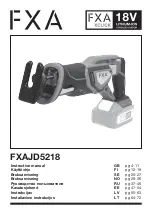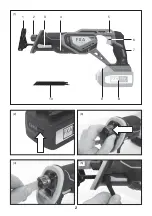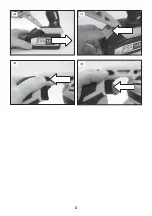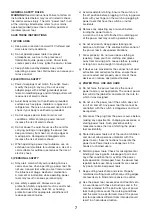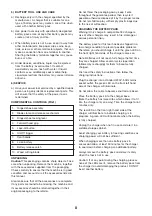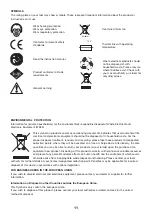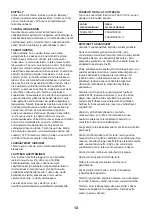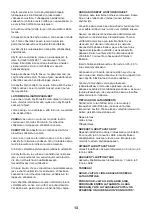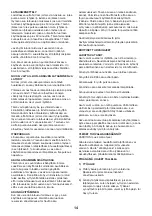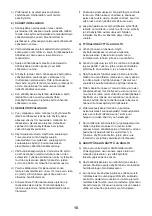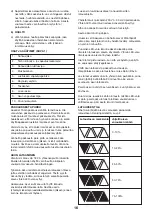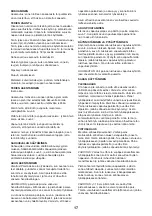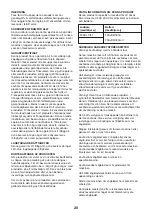
5
Ensure that there are no obstructions underneath the
workpiece, it is easy to cut into sawhorses and bench
tops. Hold the machine correctly and adopt a stable
stance.
Use clamps or other practical way to secure and
support the workpiece to a stable platform. Holding
the workpiece by hand or against your body leaves it
unstable and may lead to loss of control.
Do not attempt to modify the machine or its
accessories in any way.
Do not force the machine let the machine do the work.
This will reduce the wear on the machine and blade
increasing its efficiency and operating life.
Approved ear defenders should be worn when using
power saws.
Always wear eye protection with side shields marked
to comply with ANSI Z87.1. Failure to do so could
result in objects being thrown into your eyes, resulting
in possible serious injury.
Protect your lungs. Wear a face or dust mask if the
operation is dusty. Following this rule will reduce the
risk of serious personal injury.
Do not wear loose clothing or jewellery. Contain long
hair. Loose clothes, jewellery, or long hair can be
drawn into air vents.
ADDITIONAL SAFETY RULES CHARGERS
1. Before using the charger, read all the instructions
and cautionary markings on the charger and battery
pack as well as the instructions on using the battery
pack.
2. Only charge your batteries indoors as the charger is
designed for indoor use only.
3.
DANGER!
If the battery pack is cracked or
damaged in any other way, do not insert it in the
charger. There is a danger of electric shock or
electrocution.
4.
WARNING!
Do not allow any liquid to come into
contact with the charger. There is a danger of electric
shock.
5. The charger and battery packs supplied with it are
specifically designed to work together. Do not attempt
to charge the battery pack with any other charger than
the one supplied.
6. Do not pull on the power cord to disconnect it from
the mains supply socket.
7. Do not use the charger if it has been subjected to a
heavy knock, dropped or otherwise damaged in any
way. Take the charger to an authorised service centre
for a check or repair.
8. Do not disassemble the charger. Take it to an
authorised service centre when service or repair is
required. Incorrect re-assembly may result in the risk
of fire, electric shock or electrocution.
9. To reduce the risk of an electric shock, unplug the
charger from the power supply before attempting to
clean it. Removing the battery alone does not reduce
the risk.
ADDITIONAL SAFETY RULES FOR THE BATTERY
PACK
1. The battery pack for this tool has been shipped in a
low charge condition. You should charge the battery
pack fully before use.
2. Do not incinerate the battery pack even if it is
seriously damaged or can no longer hold a charge.
The battery pack can explode in a fire.
3. A small leakage of liquid from the battery pack may
occur under extreme usage or temperature conditions.
This does not necessarily indicate a failure of the
battery pack. However, if the outer seal is broken and
this leakage comes into contact with your skin wash
the affected area quickly with soap and water. If the
leakage gets in your eyes flush your eyes with clean
water for a minimum of 10 minutes and seek
immediate medical attention.
Inform the medical staff that the liquid is a 25-35%
solution of potassium hydroxide.
4. Never attempt to open the battery pack for any
reason. If the plastic housing of the battery pack
breaks open or cracks, immediately discontinue its
use and do not recharge it.
5. Do not store or carry a spare battery pack in a
pocket or toolbox or any other place where it may
come into contact with metal objects. The battery
pack may be short- circuited causing damage to the
battery pack, burns or a fire.
BATTERY CHARGING INFORMATION
Charging rates for NiCad and/or Li-Ion NiCad and/or
Li-Ion battery charging rates are determined by the
time taken to fully charge the battery and are
determined by the charge current. The three most
commonly used charging rates are typically:
Fast charge.
Slow charge.
Trickle charge.
FAST CHARGE BATTERIES
The charging rates for fast charge batteries can vary
between 30 minutes and 90 minutes. The charging
rate for the battery supplied with a cordless power
tool is stated in the product manual.
SLOW CHARGE BATTERY
The charging rates for slow charge batteries are
between 3 hours and 5 hours.
TRICKLE CHARGE BATTERIES
The charging rates for trickle charge batteries are
between 7 hours and 9 hours.
Summary of Contents for XCLICK FXAJD5218
Page 2: ...2 1 7 1 5 3 2 9 8 6 10 4 5 3 2 4...
Page 3: ...3 8 9 7 6...
Page 37: ...37 2 FXA XCLICK FXADL1051 FXAJDB180Li FXAJDB180Li II...
Page 38: ...38 ANSI Z87 1 10 25 35...
Page 39: ...39 30 90 3 5 7 9 30 30 30 45 30 45 5 3...
Page 40: ...40 1 2 3...
Page 41: ...41 4 5 a b c d 6...
Page 42: ...42 1 18 230 50 60 30 1 2 3 4 5 6 7 8 9 10...
Page 43: ...43 2 10 14 18 3 4 5 6 0 10 10 25 25 50 50 75 75 100...
Page 44: ...44 7 8 9 15...
Page 45: ...45 18 0 3000 25 4 80 10 LpA 81 A K 3 A LWA 92 A K 3 A 8 3 2 K 1 5 2 WEEE...
Page 46: ...46 130 Li ion...
Page 73: ...73...
Page 74: ...74...
Page 75: ...75...

